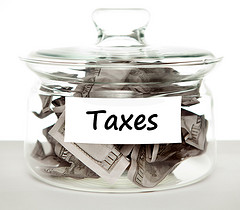 |
| Taxes (Photo credit: Tax Credits) |
If your income, or part of your income, is from a source other than an employer who provides you with a W2 and therefore withholds taxes on your behalf through the year, you may need to make estimated tax payments. There are ways around this, such as having tax withheld from your pension or Social Security payments. But for some folks, estimated tax payments are the way to get your tax paid through the year.
If your only income for the year is from withdrawals from an IRA, you don’t need to make quarterly payments, you can wait until the end of the year to withdraw the amount you need to pay in tax. Otherwise, for most other types of income you need to pay tax as you receive it during the year. You will make one payment in mid-April for your income through March 31; another in mid-June for income through May 31; a third in mid-September for income through August 31, and a final payment by mid-January of the following year for income to December 31.
The IRS recently published their Tax Tip 2012-65, which includes tips for people who pay estimated taxes. Below is the text of the Tip:
Six Tips for People Who Pay Estimated Taxes
You may need to pay estimated taxes to the IRS during the year if you have income that is not subject to withholding. This depends on what you do for a living and the types of income you receive.
These six tips from the IRS explain estimated taxes and how to pay them.
- If you have income from sources such as self-employment, interest, dividends, alimony, rent, gains from the sales of assets, prizes or awards, then you may have to pay estimated tax.
- As a general rule, you must pay estimated taxes in 2012 if both of these statements apply: 1) You expect to owe at least $1,000 in tax after subtracting your tax withholding (if you have any) and tax credits, and 2) You expect your withholding and credits to be less than the smaller of 90 percent of your 2012 taxes or 100 percent of the tax on your 2011 return. Special rules apply for farmers, fishermen, certain household employers and certain higher income taxpayers.
- For Sole Proprietors, Partners and S Corporation shareholders, you generally have to make estimated tax payments if you expect to owe $1,000 or more in tax when you file your return.
- To figure your estimated tax, include your expected gross income, taxable income, taxes, deductions and credits for the year. Use the worksheet in Form 1040-ES, Estimated Tax for Individuals, for this. You want to be as accurate as possible to avoid penalties. Also, consider changes in your situation and recent tax law changes.
- The year is divided into four payment periods, or due dates, foe estimated tax purposes. Those dates generally are April 15, June 15, September 15, and January 15 of the next or following year.
- Form 1040-ES, Estimated Tax for Individuals, has everything you need to pay estimated taxes. It includes instructions, worksheets, schedules and payment vouchers. However, the easiest way to pay estimated taxes is electronically through the Electronic Federal Tax Payment System, or EFTPS, at www.irs.gov. You can also pay estimated taxes by check or money order using the Estimated Tax Payment Voucher or by credit or debit card.
For more information on estimated taxes, refer to Form 1040-ES and its instructions and Publication 505, Tax Withholding and Estimated Tax. These forms and publications are available at www.irs.gov or by calling 800-TAX-FORM (800-829-3676).



 Sterling Raskie, MSFS, CFP®, ChFC®
Sterling Raskie, MSFS, CFP®, ChFC® The latest in our Owner’s Manual series, A 401(k) Owner’s Manual, was published in January 2020 and is available on
The latest in our Owner’s Manual series, A 401(k) Owner’s Manual, was published in January 2020 and is available on  A Medicare Owner’s Manual, is updated with 2020 facts and figures. This manual is available on
A Medicare Owner’s Manual, is updated with 2020 facts and figures. This manual is available on  Social Security for the Suddenly Single can be found on Amazon at
Social Security for the Suddenly Single can be found on Amazon at  Sterling’s first book, Lose Weight Save Money, can be
Sterling’s first book, Lose Weight Save Money, can be  An IRA Owner’s Manual, 2nd Edition is available for purchase on Amazon. Click the link to choose the
An IRA Owner’s Manual, 2nd Edition is available for purchase on Amazon. Click the link to choose the  Jim’s book – A Social Security Owner’s Manual, is now available on Amazon. Click this link for the
Jim’s book – A Social Security Owner’s Manual, is now available on Amazon. Click this link for the  And if you’ve come here to learn about queuing waterfowl, I apologize for the confusion. You may want to discuss your question with Lester, my loyal watchduck and self-proclaimed “advisor’s advisor”.
And if you’ve come here to learn about queuing waterfowl, I apologize for the confusion. You may want to discuss your question with Lester, my loyal watchduck and self-proclaimed “advisor’s advisor”.
Should an estimate of capital gains, if taken, be included in estimated taxes even if in 15% tax bracket? I understand there wil be no capital gains tax in 2012 for those in 10-15% tax bracket. However, it does affect taxable social security.
Ron, capital gain estimates are a part of the calculation on Form 1040-ES. Most certainly these should be included but only at the appropriate rates and you’ll need to adjust to match your circumstances (such as the zero cap gains rate for 15% bracket or lower).
jb